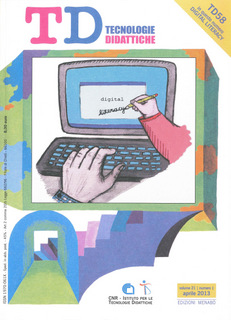Why introduce ICT in schools? A road map for decision makers and teachers
Main Article Content
Abstract
Article Details
Section
Authors who publish with this journal agree to the following terms:
- Authors retain copyright and grant the journal right of first publication with the work simultaneously licensed under a Creative Commons CC BY 4.0 Attribution 4.0 International License.
- Authors are able to enter into separate, additional contractual arrangements for the non-exclusive distribution of the journal's published version of the work (e.g., post it to an institutional repository or publish it in a book), with an acknowledgement of its initial publication in this journal.
- Authors are permitted and encouraged to post their work online (e.g., in institutional repositories or on their website) prior to and during the submission process, as it can lead to productive exchanges, as well as earlier and greater citation of published work (See The Effect of Open Access)
References
Bennett S., Maton K., Kervin L. (2008). The ‘digital natives’ debate. A critical review of the evidence. British Journal of Educational Technology, 39 (6), pp. 775-786.
Bernard R.M., Abrami P.C., Lou Y., Borokhovski E., Wade A., Wozney L., Wallet P.A., Fiset M., Huang B. (2004). How does distance education compare with classroom instruction? A meta-analysis of the empirical literature. Review of Educational Research, 74 (3), pp. 379-439.
Brand-Gruwel S., Wopereis I., Vermetten Y. (2005). Information problem solving by experts and novices: Analysis of a complex cognitive skill. Computers in Human Behavior, 21, pp. 487- 508.
Bruni F. (2009). Blog e didattica. Macerata, IT: Eum.
Burgstahler S. (2003). The role of technology in preparing youth with disabilities for postsecondary education and employment. Journal of Special Education Technology. 18 (4), pp. 7-19.
Calvani A, Fini A., Ranieri M, Picci. P. (2011). Are young generations in secondary school digitally competent? A study on Italian teenagers. Computers & Education, 58, pp.797-80.
Carr N.(2011). Internet ci rende stupidi? Come la rete sta cambiando il nostro cervello. Milano, IT: Cortina.
Chen S.Y., Fan J.P., Macredie R.D. (2006). Navigation in hypermedia learning systems: experts vs. novices. Computers in Human Behavior, 22 (2), pp. 251-266.
Clark R.C., Nguyen F., Sweller J. (2006). Efficiency in learning: Evidence-based guidelines to manage cognitive load. San Francisco, CA, USA: Pfeiffer.
Csikszentmihalyi M. (1992). Flow, the Psychology of Happiness. London, UK: Rider.
Cuban L. (1986). Teachers and machines. The classroom use of technologies since 1920. New York, USA: Teachers College Press.
Cullen J. (2007). Status of e-inclusion measurement, analysis and approaches for improvement, Final Report EU. Brussels, BE: European Commission.
EU (2006). Recommendation the European Parliament and the Council of 18th December 2006 on Key Competences for Lifelong Learning. Official Journal of the European Union (2006/962/EC), L394/10-18.
Fedeli L. (2012). Social media e didattica, Opportunità, criticità e prospettive. Lecce, IT: Pensa Multimedia.
Gui M. (2012). Uso di Internet e livelli di apprendimento. Una riflessione sui sorprendenti dati dell’indagine Pisa 2009. Media Education, Studi, Ricerche, Buone pratiche, 3 (1), pp. 29-42.
Hattie J. (2009). Visible learning: A synthesis of over 800 meta-analyses relating to achievement. London, New York: Routledge.
Hattie J. (2012). Visible learning for teachers: Maximizing impact on learning. London and New York: Routledge.
Kirschner P.A., Sweller J.E., Clark R.E. (2006).Why minimal guidance during instruction does not work: An analysis of the failure of constructivist, discovery, problem-based, experiential, and inquiry- based teaching. Educational Psychologist, 41 (2), 75–86.
Kozma R. (1994). Will media influence learning: reframing the debate. Educational Technology Research and Development, 42 (2), pp. 7-19.
Margaryan A., Littlejohn A. (2008). Are digital natives a myth or reality?. Students’ use of technologies for learning. http://www.academy.gcal.ac.uk/anoush/documents/ DigitalNativesMythOrReality-MargaryanAndLittlejohn- draft-111208.pdf (ultima consultazione 22.08.2012).
Martin S.S. (2005). Special education, technology and teacher education, http://site.aace.org/pubs/foresite/SpecialEducation. pdf (ultima consultazione 22.08.2012).
Mayer R.E. (2004). Should there be a three-strikes rule against pure discovery learning? The case for guided method of instruction. American Psychologist, 59 (1), pp. 14-19.
OECD (2011). PISA 2009 Results: students on line: digital technologies and performance,VI. Paris: OECD.
Ong W. (1986). Oralità e scrittura. Le tecnologie della parola. Bologna, IT: Il Mulino.
Ranieri M. (2011). Le insidie dell’ovvio. Tecnologie educative e critica della retorica tecnocentrica. Pisa, IT: ETS.
Russell T.L. (1999). No significant difference phenomenon. Raleigh, NC, USA: North Carolina State University.
Salomon G., Perkins D. N., Globerson T. (1991). Partners in Cognition: Extending human intelligence with intelligent technologies. Educational Researcher, 20 (3), pp. 2-9.
Small G., Vorgan G. (2008). Ibrain: surviving the technological alteration of the modern mind. New York, USA: Collins.
Thomas D., Brown J.S. (2011). A new culture of learning. Cultivating the imagination for a world of constant change. Lexington, KY, USA: Create- Space.

